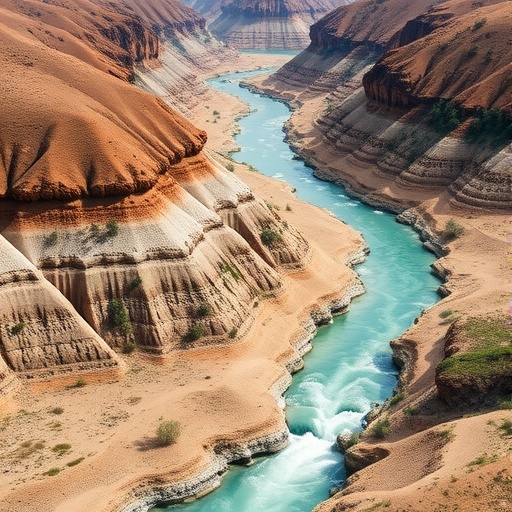In a groundbreaking study focusing on the hydrological evolution of China’s renowned Loess Plateau, researchers have unveiled intricate dynamics behind runoff generation within watersheds experiencing profound environmental transformations. This research, recently published in Environmental Earth Sciences, delves into the interplay of natural and anthropogenic factors that collectively influence runoff patterns, offering a kaleidoscopic view of how watersheds respond to both climatic and land-use changes over time. The Loess Plateau, known for its deep, loose soil deposits and vulnerability to erosion, has been a focal point for understanding watershed hydrology under the pressure of swift environmental changes.
The investigation centers on a watershed subjected to significant environmental shifts, encompassing changes driven by climate variability alongside human intervention such as reforestation, terracing, and agricultural practices. These diverse influences alter soil porosity, vegetation cover, and surface roughness, cumulatively affecting how water infiltrates, percolates, and eventually contributes to surface runoff. The research team employed advanced hydrological modeling integrated with field observations to dissect the mechanisms controlling runoff generation, ultimately highlighting the complex feedback loops between the environment and water flow.
One of the most compelling findings is the nuanced role of vegetation recovery efforts, which, while intended to mitigate erosion and enhance soil stability, exert multifaceted effects on runoff. Enhanced vegetation density increases canopy interception and root absorption, reducing surface runoff. However, in certain contexts, the uptake of water by plants can lower soil moisture levels, inadvertently promoting faster runoff during heavy rainfall events due to decreased infiltration capacity. This paradoxical effect underscores the importance of tailoring land management strategies to localized hydrological conditions.
Furthermore, the study underscores the Loess Plateau’s unique topographical and soil characteristics that govern hydrological responses. The highly erodible loess soil exhibits variable permeability depending on its consolidation and moisture status. Land use changes, particularly terracing, alter the microtopography and soil compaction, thereby transforming infiltration patterns. Terraced slopes slow down runoff velocity, facilitating water recharge into the soil, but their effectiveness is contingent upon maintenance and design, as poorly managed terraces can exacerbate runoff and erosion instead.
Climate variability emerges as a critical driver influencing runoff trends. The research demonstrates that shifts in precipitation intensity and distribution markedly impact runoff volumes, with episodic heavy storms leading to disproportionate increases in surface runoff due to soil saturation and reduced infiltration capacity. Such precipitation extremes challenge watershed resilience, compounding the effects of land management interventions and necessitating adaptive strategies to buffer against hydrological extremes.
Hydrological modeling in this study was underpinned by the integration of high-resolution spatial datasets, including soil moisture profiles, vegetation indices, and topographic metrics. By simulating different scenarios of environmental change, the researchers could unravel the relative contributions of climatic factors versus land-use modifications in driving runoff variability. This approach revealed temporal shifts in runoff generation mechanisms, showcasing how seasonal vegetation dynamics and soil conditions interplay with rainfall events to determine flow responses.
Notably, the research highlights the shifting dominance between subsurface and surface runoff depending on environmental conditions. In wetter periods and locations with well-conserved vegetation, subsurface flow pathways dominate, enhancing groundwater recharge and reducing flood risk. Conversely, during dry spells or in degraded areas with bare or compacted soil, surface runoff prevails, accelerating soil erosion and transporting sediments downstream. This duality emphasizes the importance of maintaining watershed integrity to regulate hydrological fluxes sustainably.
The findings also illuminate the broader consequences of runoff changes for ecosystem services and human livelihoods in the Loess Plateau region. Increased surface runoff can lead to soil degradation and reduced agricultural productivity, threatening food security in a region where millions depend on rain-fed farming. Conversely, improved runoff regulation through ecological restoration helps stabilize soils and replenish aquifers, contributing to long-term water security. These insights stress the critical interdependence between watershed management and socio-economic resilience.
Importantly, the study sheds light on the temporal lag between environmental interventions and hydrological responses. Restoration activities such as reforestation do not yield immediate changes in runoff regimes; rather, their benefits accrue over years to decades as vegetation matures and soil structure improves. This temporal dimension necessitates patience and sustained commitment from policymakers and local communities to realize the full potential of ecological restoration in modulating hydrological cycles.
The authors advocate for integrating their hydrological findings into adaptive watershed management frameworks tailored to the unique challenges of the Loess Plateau. Monitoring networks combining meteorological, soil, and hydrological data are vital for tracking ongoing environmental changes and validating model projections. Such real-time data streams enable timely adjustments to land use practices to balance erosion control, water conservation, and agricultural needs effectively.
The implications of this research extend beyond the Loess Plateau, offering a paradigm for other regions grappling with the dual pressures of environmental change and sustainable water management. By elucidating the complex controls on runoff generation, this work informs global efforts to combat land degradation, enhance water resources, and build climate resilience in vulnerable watersheds. The study serves as a clarion call for interdisciplinary collaboration bridging hydrology, ecology, and socioeconomics to safeguard water security under accelerating environmental change.
In conclusion, this comprehensive investigation enriches our understanding of the multifaceted controls on runoff dynamics within a rapidly transforming watershed landscape. Through sophisticated modeling and empirical insights, it unravels the intertwined roles of vegetation, soil, climate, and human interventions in shaping hydrological outcomes. The findings underscore the necessity of nuanced, context-sensitive watershed management strategies that account for ecological complexities and anticipate future climatic uncertainties. This research contributes a vital piece to the puzzle of sustaining water and soil resources in one of China’s most environmentally fragile yet socioeconomically significant regions.
Subject of Research: Runoff generation mechanisms and controls in a watershed undergoing substantial environmental changes, focusing on China’s Loess Plateau.
Article Title: Changes and controls of runoff generation in a watershed with substantial environmental change in China’s Loess Plateau.
Article References: Wang, M., Yan, X., Han, Z. et al. Changes and controls of runoff generation in a watershed with substantial environmental change in China’s Loess Plateau. Environ Earth Sci 84, 540 (2025). https://doi.org/10.1007/s12665-025-12578-6
Image Credits: AI Generated




